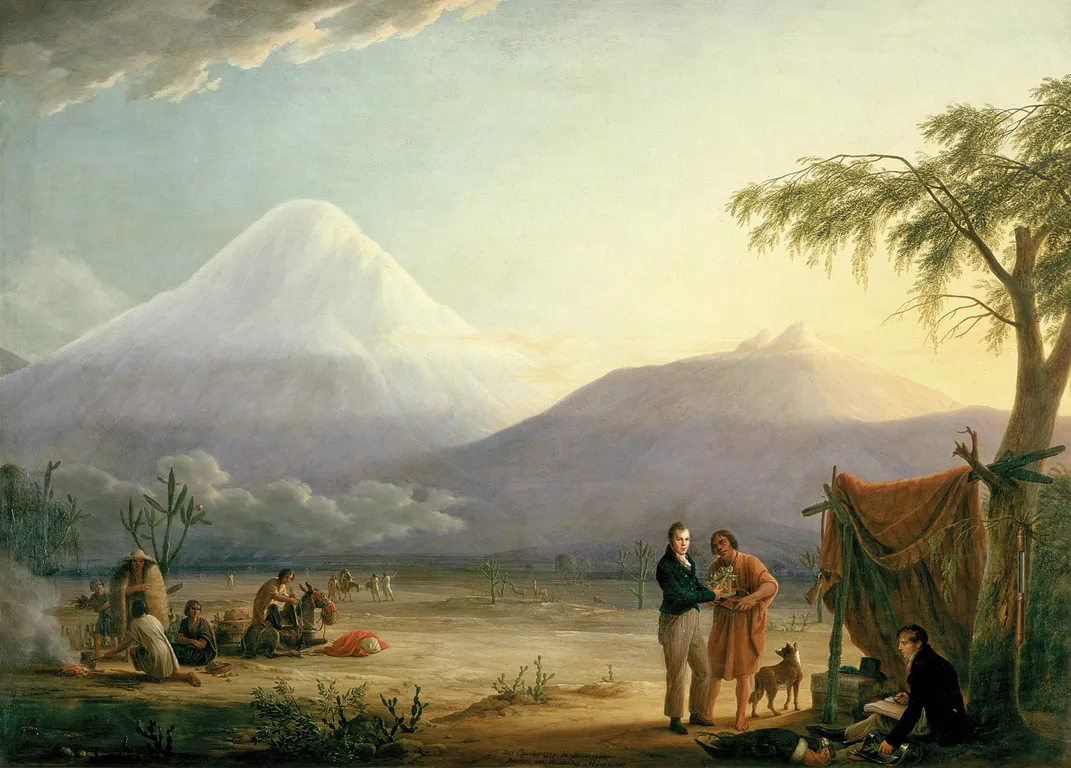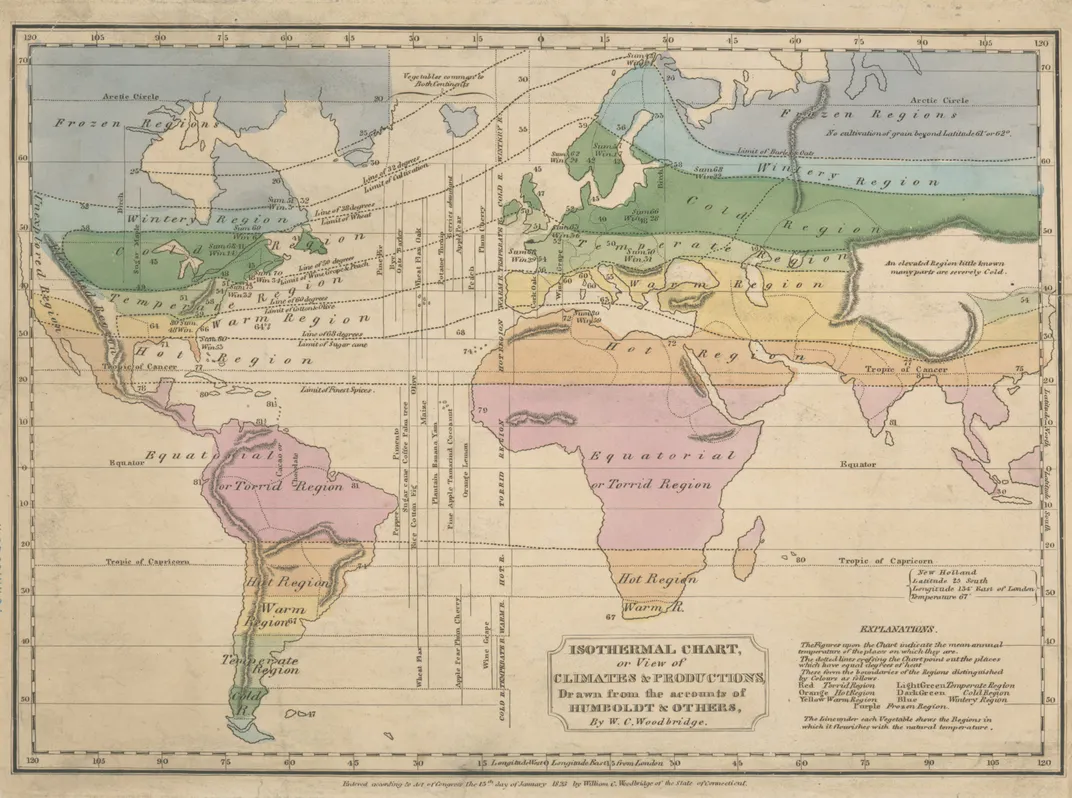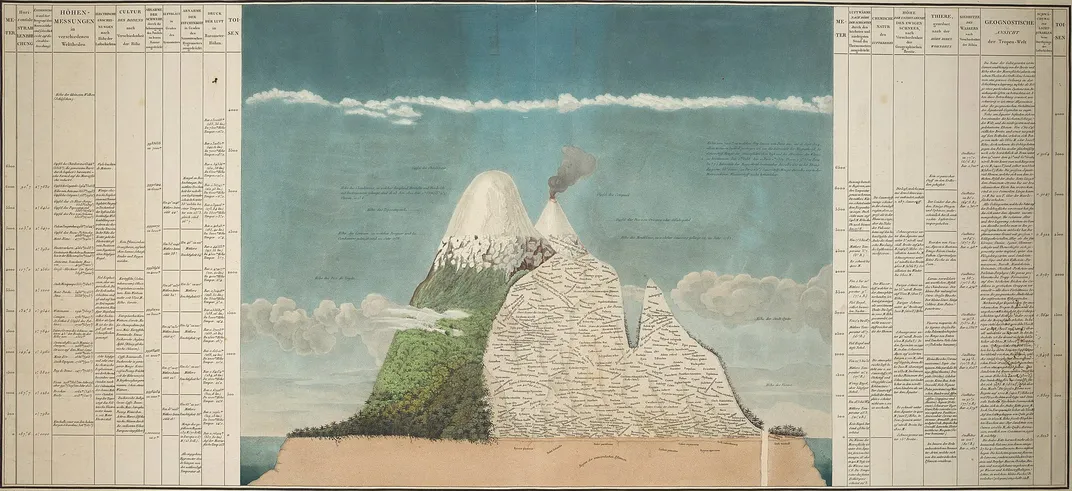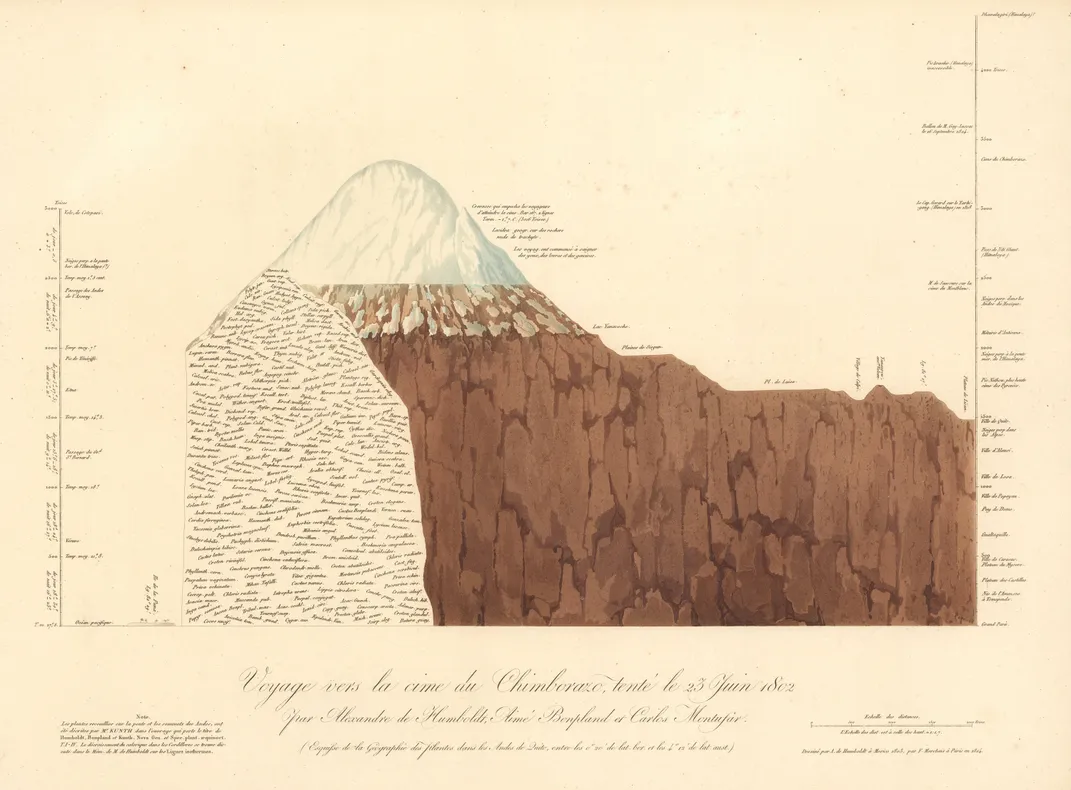The Pioneering Maps of Alexander von Humboldt
Beautiful and insightful, the illustrations of the German naturalist helped shape a new understanding of the world
:focal(1157x1514:1158x1515)/https://tf-cmsv2-smithsonianmag-media.s3.amazonaws.com/filer/96/81/9681f8b5-3026-42fe-acb1-7eca1a5cbe1c/wikicommons-geographie_der_pflanzen_cropped.jpg)
The German naturalist and explorer Alexander von Humboldt was one of the most celebrated scientists of the 19th century. In 1869, on the 100th anniversary of his birth, 25,000 people gathered in New York's Central Park to listen to speeches extolling his accomplishments and witness the unveiling of a large bronze bust of Humboldt, who had died ten years earlier. Flags and enormous posters showing Humboldt's face lined the streets of Manhattan. Similar celebrations took place around the world—in Berlin, Humboldt's birthplace, 80,000 admirers gathered in the chilly rain to listen to eulogies and songs sung in his honor.
It's hard to imagine any modern scientist achieving such celebrity, and now, 250 years after his birth, Humboldt himself has largely been forgotten by the general public. But as historian Andrea Wulf wrote in her 2015 biography of Humboldt, The Invention of Nature, his scientific legacy lives on in scores of geographic features and place names, from a glacier in Greenland to a mountain range in Antarctica. (The state of Nevada was almost named Humboldt, Wulf writes.) The Latin names of nearly 300 plants and more than 100 animals pay homage to him, including the aggressive, predatory Humboldt squid, which can grow up to eight feet long and weigh 100 pounds.
Humboldt's major scientific contribution was realizing the interconnectedness of climate, geography, nature, and human societies. His ideas were revolutionary for the 19th century, and they remain relevant today for scientists studying the effects of climate change. Next spring, the Smithsonian American Art Museum opens a new show "Alexander von Humboldt and the United States: Art, Nature, and Culture," examining the naturalist's transformative influences.

What’s often omitted, however, in discussions of Humboldt’s scientific legacy is the role that his pioneering maps and scientific illustrations played in shaping his thinking. By creating visualizations of data that had previously been bound up in tables, Humboldt revealed connections that had eluded others, says historian Susan Schulten of the University of Denver. “He’s really a visual thinker,” she says.
According to Schulten, Humboldt was one of the first scientists to use maps to generate and test scientific hypotheses. One example was his use of what he called “isotherm” lines to indicate regions of the globe with the same average temperature. These lines are ubiquitous on weather maps today, and they seem so obvious we take them for granted. But when Humboldt published a map using them in 1817, it caused scientists to rethink the widely held assumption that the average temperature of a region depends primarily on its latitude. The isotherm lines on Humboldt’s map had ups and downs that deviated from lines of latitude. This prompted him and others to look for explanations, and eventually led to an understanding of how ocean currents, mountain ranges, and other features of geography contribute to local climates.

Another of Humboldt’s groundbreaking illustrations came out of his five-year voyage to Central and South America with the French botanist Aimé Bonpland. In 1802, Humboldt and Bonpland ascended Chimborazo, a volcano just below the equator that was believed at the time to be the highest mountain in the world (at 20,564 feet, it’s more than 8,000 feet shorter than Mount Everest). The pair documented the mountain’s plant life, from the tropical rainforest at its base to the lichen clinging to rocks above the treeline. The image below, which Humboldt called Tableau Physique in the French version of his original publication, organizes these observations in an intuitively visual way, showing Chimborazo in cross-section, with text indicating which species lived at different elevations on the mountain.

Columns of text on either side of the Chimborazo cross-section indicate precipitation, humidity, and other measurements Humboldt took at various elevations. “He’s trying to think about how all these elements of the landscape fit together and impinge on one another,” Schulten says. In contrast to scientists before him who’d used maps and illustrations primarily to describe and summarize their findings, Humboldt used his visualizations to look for explanations, she says.
Humboldt’s eye-catching Tableau caught on quickly and inspired many imitations. The illustration below by the Scottish cartographer Alexander Keith Johnston, which appeared in an 1850 atlas, depicts the distribution of plants at different elevations for several mountain ranges, including the Andes, the Himalayas and the Alps. It expands on Humboldt’s Chimborazo illustration by showing how the zones inhabited by different species vary according to latitude as well as elevation.

In recent years, two teams of scientists have attempted to use Humboldt’s Tableau as a historical benchmark to compare against more recent surveys on Chimborazo. As the global climate has warmed, the habitat of many plant species has shifted to higher elevations in mountainous regions, and Humboldt’s Tableau presents a rare opportunity to compare the modern distribution of species with their distribution two centuries ago, just as the Industrial Revolution—and the industrial scale generation of greenhouse gases—was getting underway.
Only, it’s not quite that simple, one of the teams recently reported in the Proceedings of the National Academy of Sciences. The researchers re-examined Humboldt’s diaries and concluded that many of the species he included on the upper reaches of his Chimborazo illustration had been observed instead on a nearby volcano, Antisana. The researchers see their findings as a cautionary tale about taking Humboldt’s Tableau too literally or assuming it meets 21st-century standards of scientific rigor. Even so, when the researchers compared the Tableau with recent surveys on Antisana, they found that plant species had shifted up the mountain 700-900 vertical feet since Humboldt’s time, consistent with the rate of change scientists have observed in other parts of the world.
“Thus, the Tableau is both fiction and fact, a work in progress, an attempt to illustrate general plant distribution patterns on the equatorial peaks of South America,” the Norweigian ecologist Geir Hestmark wrote in a commentary accompanying the PNAS paper.

Despite their shortcomings, Humboldt’s use of maps as tools of scientific exploration put him on the cutting edge of a revolution in cartography in the 19th century, Schulten writes in her 2012 book, Mapping the Nation. Most maps up to that time were literal representations of a place, depicting its rivers, mountain ranges, cities and other physical features. Humboldt and others departed from this tradition by using maps to explore the geography of other, less visible things. While Humboldt’s interests centered on climate and the distribution of plants and animals, others began mapping the distribution of disease, poverty, and other aspects of the human condition.
In addition to their intellectual history, the aesthetics of Humboldt’s maps and illustrations continue to inspire cartographers today. Rosemary Wardley, a geographer and cartographer at National Geographic, says she admires Humboldt’s illustrations because they can be appreciated at multiple levels. “As geographer and cartographer that’s your ideal, you want to make something that’s approachable for all types of people but has that extra level of detail for those who want to delve in more,” Wardley says. “If something is eye catching it draws people in and gets them to think about something they weren’t interested in before.”